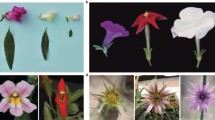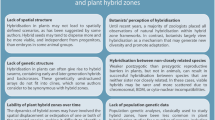Abstract
Natural hybridisation in plants is one of the most striking modes of evolution, when looking at the effects reticulation may have on patterns and processes of the evolutionary history of the affected system. Among other functional constraints, symmetry is regarded as a major factor of or for evolution. A loss of symmetry, that means origin of asymmetrical phenomena can in some cases be linked to environmental or genetic stresses, such as hybridisation. It has been shown that the discussion on reticulation and symmetrical evolution is strongly influenced by a zoocentric evolutionary view, but more focus is needed on the differences between the organisms subject to the study. Plant hybridogenic evolution with the subsequent possibility of polyploidisation and the consequent reduced homology is a completely different phenomenon compared to animal evolution. This article examines the role of symmetry for plant evolution by concentration on two topics: (a) spatial asymmetry on multiple levels caused by hybridisation, and (b) temporal asymmetry (changes of rhythms inherent to specific systems) as an effect of reticulation.
Similar content being viewed by others
References
Arnold, M.L., 1997. Natural Hybridization in Plants. Oxford University Press, New York and Oxford.
Arnold, M.L., Kentner, E.K., Johnston, J.A., Cornman, S., Bouck, A.C., 2001. Natural hybridisation and fitness. Taxon 50, 93–104.
Ax, P., 1984. Das Phylogenetische System. Systematisierung der lebenden Natur aufgrund ihrer Phylogenese. G. Fischer, Stuttgart and New York.
Ax, P., 1988. Systematik in der Biologie. Darstellung der stammesgeschichtlichen Ordnung in der lebenden Natur. G. Fischer, Stuttgart, UTB-Taschenbücher 1502.
Briggs, D., Walters, S.M., 1990. Plant Variation and Evolution. Cambridge University Press, Cambridge, MA.
Brunner, H., 1999. Rechts oder links. In der Natur und anderswo. Wiley, VCH, Weinheim.
Camerarius, R.J., 1694. Ueber das Geschlecht der Pflanzen (De sexu plantarum epistola) In: Möbius, M. (Hrsg.) (1899). Ostwalds Klassiker der exakten Wissenschaften Nr. 105. Verlag Wilhelm Engelmann, Leipzig.
Chatti, N., Said, K., Catalan, J., Britton-Davidian, J., Auffray, J.C., 1999. Developmental instability in wild chromosomal hybrids of the house mouse. Evolution 53, 1268–1279.
Cintas, P., 2002. Die Chiralität lebender Systeme: Hilfe von Kristallen und Oligopeptiden. Angew. Chem. 114 (7), 1187–1193.
Clausen, J., 1951. Stages in the Evolution of Plant Species. Cornell University Press, Ithaca, NY.
Cronquist, A., 1987. A botanical critique of cladism. Bot. Rev. 53, 1–52.
Darlington, C.D., 1937. Recent Advances in Cytology. Churchill Press, London.
Darwin, C., 1859. On the Origin of Species by Means of Natural Selection for the Preservation of Favoured Races in the Struggle for Life. Murray, London (Edition used: 1995, Die Entstehung der Arten durch natürliche Zuchtwahl. Verlag P. Reclam, Stuttgart).
Dobzhansky, T., 1939. Die genetischen Grundlagen der Artbildung. G. Fischer, Jena.
Dobzhansky, T., 1970. Genetics of the Evolutionary Process. Columbia University Press, New York and London.
Donoghue, M.J., Cantino, P.D., 1988. Paraphyly, ancestors, and the goals of taxonomy: a botanical defence of cladism. Bot. Rev. 54, 107–128.
Doyle, J.J., 1992. Gene trees and species trees: molecular systematics as one-character taxonomy. Syst. Bot. 17 (1), 144–163.
Edlinger, K., 1996. Bilateralsymmetrie und Lokomotion. In: Hahn, W., Weibel, P., (Eds.), Evolutionäre Symmetrietheorie. Selbstorganisation und dynamische Systeme. Verlag S. Hirzel, Stuttgart, pp. 77–89.
Freeman, D.C., Graham, J.H., Emlen, J.M., 1993. Developmental stability in plants: symmetries, stress and epigenesis. Genetica 89, 97–119.
Freeman, D.C., Graham, J.H., Byrd, D.W., McArthur, E.D., Turner, W.A., 1995. Narrow hybrid zone between two subspecies of big sagebrush, Artemisia tridentata (Asteraceae). III. Developmental instability. Am. J. Bot. 82 (9), 1144–1152.
Funk, V.A., 1985. Phylogenetic patterns and hybridization. Ann. Missouri Bot. Gard. 72, 681–715.
Futuyma, D.J., 1990. Evolutionsbiologie. Birkhäuser Verlag, Basel.
Gottschalk, W., 1976. Die Bedeutung der Polyploidie für die Evolution der Pflanzen. In: Heberer, G., Schwanitz, F. (Eds.), Fortschritte der Evolutionsforschung Bd. VII. G Fischer, Stuttgart.
Grant, V., 1971. Plant Speciation. Columbia University Press, New York and London.
Grasshoff, M., 1996. Strahlige Symmetrie bei Tieren. In: Hahn, W., Weibel, P. (Eds.), Evolutionäre Symmetrietheorie. Selbstorganisation und dynamische Systeme. Verlag S. Hirzel, Stuttgart, pp. 63–75.
Gutmann, W.F., 1996. Organismische Struktur als Grundlage von Symmetrie. In: Hahn, W., Weibel, P. (Eds.), Evolutionäre Symmetrietheorie. Selbstorganisation und dynamische Systeme. Verlag S. Hirzel, Stuttgart, pp. 27–40.
Hahn, W., 1989. Symmetrie als Entwicklungsprinzip in Natur und Kunst. Langewiesche, Königstein.
Hennig, W., 1950. Grundzüge einer Theorie der phylogenetischen Systematik. Deutscher Zentralverlag, Berlin.
Hennig, W., 1982. Phylogenetische Systematik. Pareys Studientexte 34. Verlag P. Parey, Berlin and Hamburg.
Hennig, W., 1984. Aufgaben und Probleme stammesgeschichtlicher Forschung. Pareys Studientexte 35. Verlag P. Parey, Berlin and Hamburg.
Humphries, C.J., Chappill, J.A., 1988. Systematics as science. A response to Cronquist. Bot. Rev. 54, 129–144.
Johannsen, W., 1903. Über Erblichkeit in Populationen und reinen Linien. Ein Beitrag zur Beleuchtung schwebender Selektionsfragen. G. Fischer, Jena.
Klein, P., 1996. Symmetrie—universales Kausalprinzip. In: Hahn, W., Weibel, P. (Eds.), Evolutionäre Symmetrietheorie. Selbstorganisation und dynamische Systeme. Verlag S. Hirzel, Stuttgart, pp. 203–218.
Kornet, D.J., Turner, H., 1999. Coding polymorphism for phylogeny reconstruction. Syst. Biol. 48, 365–379.
Kümmerer, K., 1995. Rhythmen der Natur. Die Bedeutung von Eigenzeiten und Systemzeiten. In: Held, M., Geißler, K.A. (Eds.), Von Rhythmen und Eigenzeiten. Perspektiven einer Ökologie der Zeit. S. Hirzel, Stuttgart, pp. 169–178.
Kümmerer, K., 1997. Die Bedeutung der Zeit I: Die Vernachlässigung der Zeit in den Umweltwissenschaften. Beispiele-Folgen-Perspektiven. Z. Umweltchem. Ökotox. 9 (1), 49–54.
Kümmerer, K., Held, M., 1997a. Die Bedeutung der Zeit II: Die Umweltwissenschaften im Kontext von Zeit: Begriffe unter dem Aspekt der Zeit. Z. Umweltchem. Ökotox. 9 (3), 169–178.
Kümmerer, K., Held, M., 1997b. Die Bedeutung der Zeit III: Die Vielfalt der Zeiten in den Umweltwissenschaften: Herausforderung und Hilfe. Z. Umweltchem. Ökotox. 9 (5), 283–290.
Levin, D.A., 1971. the origin of reproductive isolating mechanisms in flowering plants. Taxon 20 (1), 91–113.
Lotsy, J.P., 1926. Evolution im Lichte der Bastardierung betrachtet. Transl. by H.N. Kooiman. Genetica VII. M. Nijhoff, Haag, 365–470.
Mayer-Kuckuck, T., 1989. Der gebrochene Spiegel. Symmetrie, Symmetriebrechung und Ordnung in der Natur. Birkhäuser Verlag, Basel.
Mayr, E., 1963. Animal species and evolution. The Belknap Press Harvard University Press, Cambridge, MA.
Mayr, E., 1965. Numerical phenetics and taxonomic theory. Syst. Zool. 14, 73–97.
Mayr, E., 1967. Artbegriff und Evolution. Paul Parey, Hamburg and Berlin.
McDade, L., 1990. Hybrids and phylogenetic systematics. I. Patterns of character expression in hybrids and their implications for cladistic analysis. Evolution 44, 1685–1700.
McDade, L., 1992. Hybrids and phylogenetic systematics. II. The impact of hybrids on cladistic analysis. Evolution 46, 1329–1346.
Møller, A.P., Swaddle, J.P., 1997. Asymmetry, Developmental Stability, and Evolution. Oxford University Press, Oxford.
Nei, M., 1987. Molecular evolutionary genetics. Columbia University Press, New York.
Nichols, R., 2001. Gene trees and species trees are not the same. Trends Ecol. Evol. 16 (7), 358–364.
Parsons, P.A., 1992. Fluctuating asymmetry: a biological monitor of environmental and genomic stress. Heredity 68, 361–364.
Philiptschenko, J., 1927. Variabilität und Variation. Verlag Gebrüder Bornträger, Berlin.
Rannala, B., 1995. Polymorphic characters and phylogenetic analysis: a statistical perspective. Syst. Biol. 44, 412–429.
Riedl, R., 1975. Die Ordnung des Lebendigen. Systembedingungen der Evolution. Verlag P. Parey. Hamburg and Berlin.
Rieseberg, L.H., Ellstrand, N.C., 1993. What can molecular and morphological markers tell us about plant hybridization? Crit. Rev. Plant Sci. 12 (3), 213–241.
Ritland, K., Eckenwalder, J.E., 1992. Polymorphism, hybridization, and variable evolutionary rate in molecular phylogenies. In: Soltis, P.S., Soltis, D.E., Doyle, J.J. (Eds.), Molecular Systematics of Plants. Chapman & Hall, New York, London, pp. 404–428.
Schemske, D.W., 2000. Understanding the origin of species. Evolution 54, 1069–1073.
Sewertzoff, A.N., 1931. Morphologische Gesetzmässigkeiten der Evolution. G. Fischer, Jena.
Simpson, G.W., 1951. Zeitmaße und Ablaufformen der Evolution. Wissenschaftlicher Verlag “Musterschmidt”, Göttingen.
Sitte, P., 1986. Bio-Symmetrie. In: Symmetrie in Kunst, Natur und Wissenschaft, vol. 1. Ausstellungskatalog Mathildenhöhe Darmstadt, pp. 47–58.
Sitte, P., 1988. Symmetrie. In: Herder, F., et al. (Eds.), Lexikon der Biologie, vol. 8. pp. 128–131.
Small, R.L., Wendel, J.F., 2000. Copy number lability and evolutionary dynamics of the Adh gene family in diploid and tetraploid cotton (Gossypium). Genetics 155, 1913–1926.
Small, R.L., Wendel, J.F., 2002. Differential evolutionary dynamics of duplicated paralogous Adh loci in allotetraploid cotton (Gossypium). Mol. Biol. Evol. 19 (5), 597–607.
Small, R.L., Ryburn, J.A., Wendel, J.F., 1999. Low levels of nucleotide diversity at homoeologous Adh Loci in allotetraploid cotton (Gossypium L.). Mol. Biol. Evol. 16 (4), 491–501.
Stebbins, G.L., 1950. Variation and Evolution in Plants. Columbia University Press, New York, 2. Printing 1951, Columbia Biological Series XVI.
Stebbins, G.L., 1974. Flowering Plants. Evolution Above the Species Level. Belknap Press Harvard University Press, Cambridge, MA.
Thompson, D’A.W., 1992. On growth and form, The complete revised edition. Cambridge University Press, Cambridge, MA.
Wägele, J.-W., 2001. Grundlagen der phylogenetischen Systematik. Verlag Dr. Friedrich Pfeil, München.
Wagenitz, G., 1997. The impact of molecular methods on the systematics of angiosperms. Bot. Acta 110, 274–281.
Wagenitz, G., 2003. Wörterbuch der Botanik-Die Termini in ihrem historischen Zusammenhang. Spektrum Akademischer Verlag, Heidelberg and Berlin.
Wiens, J.J., 1995. Polymorphic characters in phylogenetic systematics. Syst. Biol. 44, 482–500.
Willmann, R., 1985. Die Art in Zeit und Raum. Das Artkonzept in der Biologie und Paläontologie. P. Parey, Berlin and Hamburg.
Wilsey, B.J., Haukioja, E., Koricheva, J., Sulkinoja, M., 1998. Leaf fluctuating asymmetry increases with hybridization and elevation in tree-line birches. Ecology 79 (6), 2092–2099.
Winkler, H., 1912. Untersuchungen über Pfropfbastarde. Erster Teil: Die unmittelbare gegenseitige Beeinflussung der Pfropfsymbionten. G. Fischer, Jena.
Wissemann, V., 2000. Molekulargenetische und morphologisch-anatomische Untersuchungen zur Evolution und Genomzusammensetzung von Wildrosen der Sektion Caninae (DC) Ser. Bot. Jahrb. Syst. 122 (3), 357–429.
Wissemann, V., 2002. Perspektivische Biosystematik im historischen Kontext, eine conditio sine qua non? In: Müller-Wille, S. (Ed.) Sammeln—Ordnen—Wissen. Beiträge zu einem Festkolloquium aus Anlaß des 80 Geburtstages von Ilse Jahn. MPI for the History of Science, Preprint 215, pp. 53–57.
Wissemann, V., 2003. Hybridization and the evolution of the nrITS spacer region. In: Sharma, A.K., Sharma, A. (Eds.), Plant Genome, Biodiversity and Evolution, vol. 1. Teil A. Science Publishers, Inc., Enfield, New Hampshire, pp. 57–71.
Wuketits, F.M., 1996. Evolution und Symmetrie. In: Hahn, W., Weibel, P. (Eds.), Evolutionäre Symmetrietheorie. Selbstorganisation und dynamische Systeme. Verlag S. Hirzel, Stuttgart, pp. 13–23.
Author information
Authors and Affiliations
Rights and permissions
About this article
Cite this article
Wissemann, V. Evolution by hybridisation. The influence of reticulate evolution on biosymmetrical patterns and processes in plants. Theory Biosci. 123, 223–233 (2005). https://doi.org/10.1016/j.thbio.2004.09.003
Received:
Accepted:
Issue Date:
DOI: https://doi.org/10.1016/j.thbio.2004.09.003




